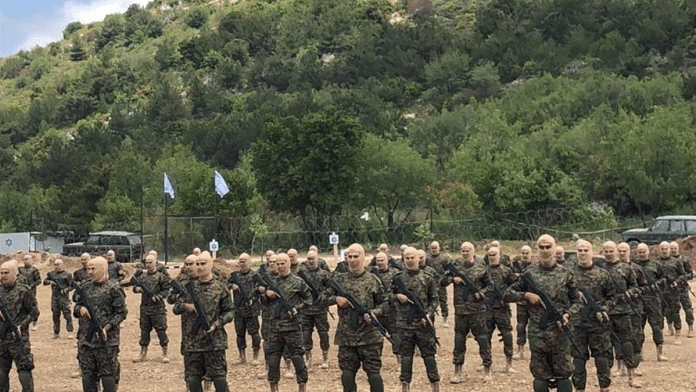New Delhi: Israel launched overnight air strikes on Hezbollah positions Tuesday in Southern Lebanon, raising fears of the opening of a second front in the ongoing Israel- Hamas conflict.
Backed by Iran, Hezbollah, a Shi’ite political party with a military arm in Lebanon, has been exchanging artillery fire with Israel in support of its ally Hamas since the start of the ongoing war on 7 October .
Hezbollah has been reticent with its intentions regarding the current war. Its deputy chief Naim Qassem is reported to have said that it was ‘fully ready’ to contribute in fighting the current conflict — making it clear that any calls to not intervene would not sway the organisation.
The Hamas terror attack has killed at least 1,300 Israelis and injured over 3,200 and captured at least 200 individuals as per the last update by the Israel Defence Forces (IDF). Israel’s retaliatory attacks have killed 2,383 Palestinians, making it one of the deadliest wars in Gaza.
Hezbollah’s reputation is that of an organisation that has grown a ‘state within a state’, with an extensive security apparatus, social service networks and its political nous, according to New York-based think tank Council on Foreign Relations (CFR).
In the 2006 Lebanon conflict, Hezbollah launched a missile, heavily damaging an Israeli naval ship, showcasing the diverse arsenal at its command – which makes it different from other non-state actors. Hezbollah has been designated as a terrorist organisation by the US, the UK, Israel and Germany.
ThePrint explains the origins of Hezbollah as well as why countries fear an expansion of the current war.
Also Read: Violent jihad vs Arafat’s legacy — Hamas & Fatah, 2 rival groups leading Palestinian cause
Origins of the Hezbollah
From 1975 to 1990, a civil war broke out in Lebanon across sectarian lines. As CFR notes in its brief, Hezbollah emerged during this time due in large part to the discontent that existed because of the large armed presence of the Palestinian Liberation Organisation (PLO).
As reported by ThePrint earlier, the PLO and its largest constituent organisation – Fatah – were expelled from Jordan in 1970 after attempting to coup King Hussein during the Jordanian Civil War. The PLO shifted its base of operation to Lebanon.
In 1943, a political compromise was struck in Lebanon, where power was shared amongst its religious communities — the President would be a Maronite Christian, the Prime Minister a Sunni Muslim, and the Speaker of Parliament a Shi’ite Muslim. This complex arrangement was undone with the PLO’s arrival to Lebanon, CFR notes.
After the Iranian revolution of 1979, a group of Lebanese Shiite funded by Iran’s Revolutionary Guard founded Hezbollah to fight against Israel after its invasion of Lebanon in 1982. The Revolutionary Guards trained and supplied weapons to this militia, which adopted the name ‘Hezbollah’, or the ‘Army of God’ in English.
In 1983, Hezbollah carried out deadly blasts, killing 299 American and French troops in Beirut. The organisation became one of the most important proxies created and funded by Iran, as Tehran looked to expand its influence in regional politics.
Two years on, Hezbollah’s political manifesto called for an Islamic Republic in Lebanon, the destruction of Israel, and pledged allegiance to the Ayatollah in Iran.
The organisation
Hassan Nasrallah took over as the Secretary General of Hezbollah in 1992 after Israel assassinated his predecessor Abbas Al-Mussawi. The organisation’s political arm is one of the largest in Lebanon, winning the most number of preferential votes during the 2022 legislative elections – 3,56,122 – and the third largest number of seats – 15 – as per a UNDP report. Its total vote share and seats won increased between 2018 and 2022.
But, its military arm is from where Hezbollah derives its international presence. As per media reports in 2021, Nasrallah boasted that Hezbollah has 1,00,000 trained fighters. ThePrint cannot independently verify this claim.
According to the US State Department, Iran has supplied Hezbollah with thousands of rockets, missiles and small arms. It notes that Tehran’s support includes hundreds of millions of dollars as well as training its fighters extensively across its camps.
Israel has long raised the spectre of Hezbollah’s growing advanced missile systems funded by Iran — which would allow the organisation to target its people from Lebanon as well as Syria, the US State Department notes.
In 2018, Center for Strategic and International Studies (CSIS) labelled Hezbollah as the world’s ‘most heavily armed non-state actor’. The Washington-based think tank notes that in 2006, Israeli sources placed the figure of Hezbollah’s missile arsenal at around 15,000 rockets. As per 2018 estimates that number stands at 130,000 rounds.
Hezbollah was used by Iran to fight for President Basheer Al-Assad during the Syrian Civil war against primarily Sunni Muslim forces, according to media reports. Its experience, large arsenal and organisation raise fears that any escalation with Israel could lead to disastrous consequences for civilians in the region.
(Edited by Tony Rai)
Also Read: 2-state solution for Israel-Palestine: History of the idea, Netanyahu’s stance & India’s position






